Ihr Warenkorb ist gerade leer!
Whitepaper The eBMC as an Implementation Tool for the Innovation Architecture
The innovation turbo
We started a trial once and filled the results from the innovation architecture into the eBMC. And lo and behold, now we had a stable basis on which to derive innovations, directions and measures; almost like in a real strategy.
That works as follows:
The innovation architecture as a basis for the delimitation of strategic focus areas
The «innovation architecture» serves to increase innovation success while taking social trends and the use of new technologies into account, by enabling simultaneous consideration or coordination of market, product and technology aspects.
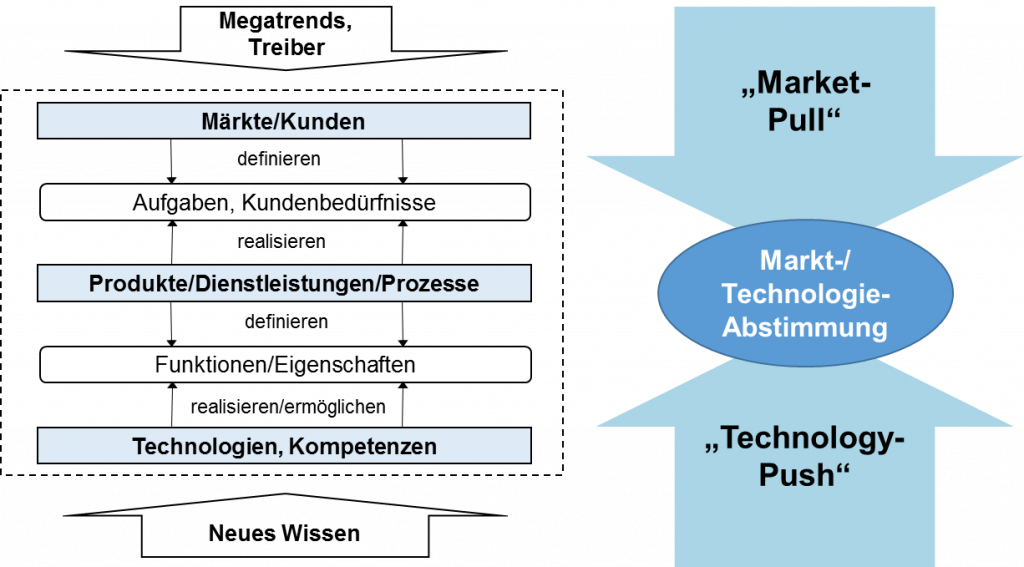
The various levels of architectural observation are logically linked from both the market and the technology point of view and are mutually dependent: On the one hand, trends affect the markets and the behavior of current and potential customers. In concrete terms, the influence of trends is expressed in specific customer tasks and needs. Satisfying these is the primary objective of shaping the market offering, i.e. products, services or business models. In order to provide this service, you need to click on of the other side requires competences or technologies. They fulfil – abstractly formulated – those functions which are necessary for the satisfaction of the customer needs are necessary.
For a Approach «from the market «, in marketing also known as «Market Pull«, we therefore try to optimize our own market offer as much as possible. to meet the needs of the markets. An essential feature of this The point of view is that the customers you want to serve are at least are known to the public to some extent. When looking at «from the technology or Competence her«, also known as «Technology Push«, this is not the case. must be the case. Rather, the question is in the foreground here which Needs in new markets on the basis of available competencies could be satisfied.
If one now fills the individual levels of the «innovation architecture» with concrete content, one obtains a suitable basis for deriving so-called «strategic focus fields» for innovation. In a somewhat abstract formulation, these are search fields for raising innovation potentials, which serve as a source for new market services or offers over a longer period of time. Within these fields, active search is now made for innovation opportunities and solutions are sought . Or something more concrete: Fields within which a company wants to innovate.
The limitation of a strategic focus field is not absolute, but it gives every company a framework to increase the chances for successful innovations and to minimize the risks.
What do we do with the result?
The identification of strategic focus areas forms the basis to fill the eBMC:
- We can create one eBMC per focus field or combine several of them. The prerequisite is that at least one business idea can be created from this.
- Then we put together the customer criteria on the one hand. For this we use common KN tools, such as the Kundennutzenanalyse or the Value Proposition Canvas (VPC). The evaluation of customer problems – customer needs – customer benefit criteria helps to precisely define and define the offer from the market point of view.
- On the other hand, we capture all the key technologies necessary for this.
- The description of the product or offer is a derivation from customer benefits and technologies. It is the solution for which the customer is willing to pay. This solution now has not only any derivation, but is strategically embedded, or in English: we have a «STRATEGIC FIT».
- Now we have to fill in the remaining fields of the eBMC, either with already existing elements or with new ones that have to be created. We recommend that new elements be highlighted in color. Immediate measures can then be derived directly from this.
- Now we embed the result into the corporate strategy and define the options, directions and measures, and the recipe is ready.
The procedure step by step
Step 1: Creating the innovation architecture
When creating the innovation architecture, the aim is to fill the above-mentioned levels with concrete content that is relevant for your own company. The following procedure has proven itself:
- Initial filling of the individual levels: This is done by collecting existing analyzes from the market and technology perspectives and comparing them with the corporate strategy.
- Complementary strategic innovation analyses to close remaining gaps in the innovation architecture: This can be achieved through partially standardized interviews with management and key persons from the areas of market, technology and product. On the other hand, targeted analyses are carried out along structured work instructions. These serve, for example, to determine the company’s own core competencies, future customer requirements, relevant megatrends and their consequences, as well as new Technologies with relevance for the company.
- Setting up the innovation architecture: The results obtained are continuously assigned to the individual levels of the innovation architecture until the picture is complete from the point of view of the core team. The art is to find a granularity suitable for further processing – not too generic, but also not too detailed. Results consisting of 40 to a maximum of 70 elements have proven themselves in practice.
Before further work is started, the innovation architecture should be adopted by the management as a suitable basis for the next steps. This includes a check of the completeness and quality of the content as well as of the granularity. The following figure shows an approved innovation architecture of a manufacturer of chemical laboratory equipment:
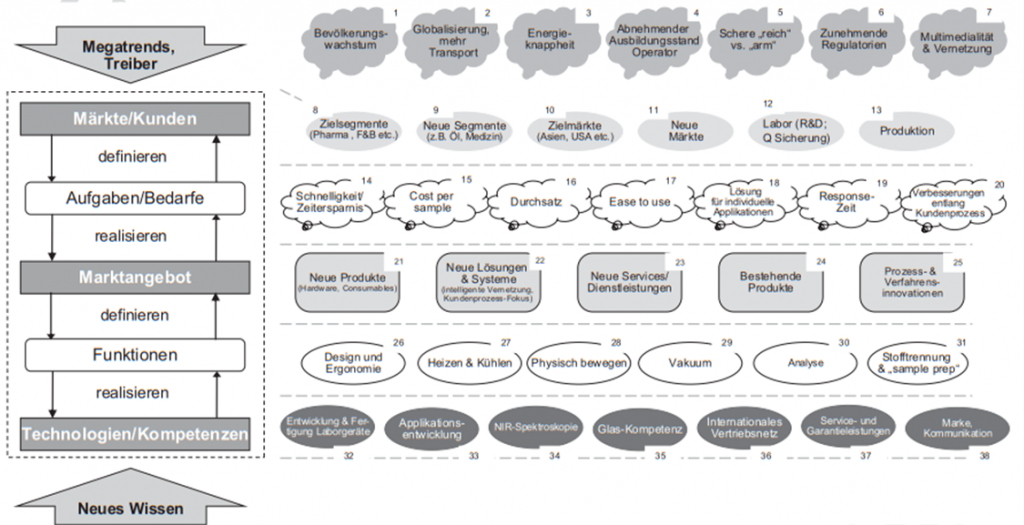
Step 2: Identification of strategic focus areas
To identify and delineate a strategic focus, a single content, such as a trend, is selected from the innovation architecture, which, from the company’s point of view, opens up opportunities for differentiating innovations. This content then serves as a «driver» or «nucleus» for the strategic focus field. Each content can already be seen as a strategic focus field on its own or, if necessary, supplemented by further contents from other levels, which should sharpen the task in a suitable manner. Since the demarcation of strategic focus areas should be in line with the corporate strategy, appropriate content should already be incorporated here. This procedure is repeated until the most attractive strategic focus areas have been identified. A number of five to a maximum of ten strategic focus areas has proven to be appropriate. The most important facts about each focus field are summarized in a profile.
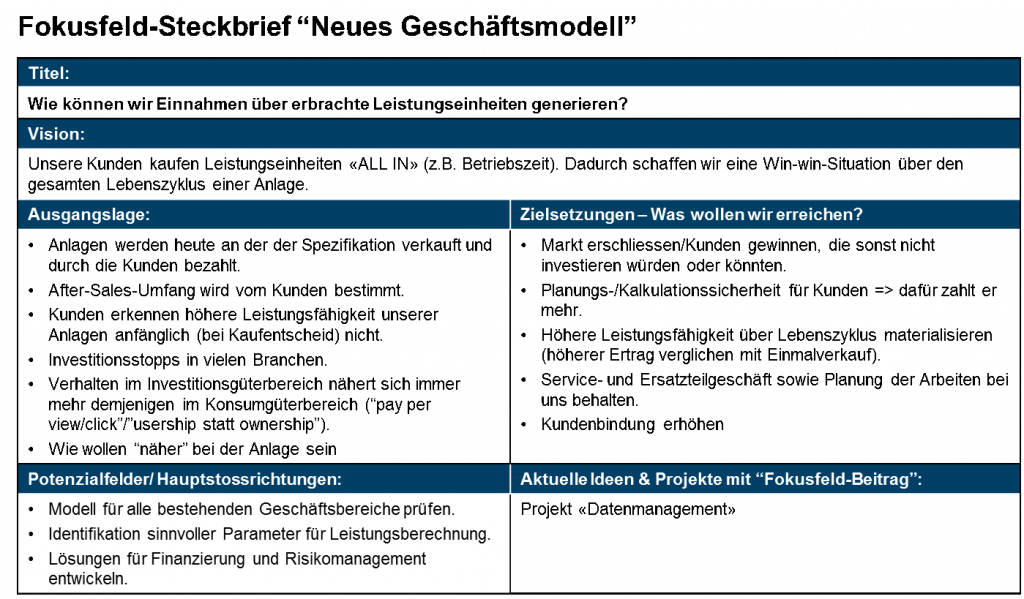
Depending on the content of the focus fields, we then either enter the eBMC via the customer problem or the technology.
Step 3: Solution-independent customer problem and solution technologies
As part of a first «exploration» of the focus areas, it is about sounding out possible innovation potentials. This primarily includes the concretization of solution-independent customer problems in the sense of articulated or inarticulate customer needs. In doing so, it is possible to fall back on proven methods of innovation management in the early stages. Possible meaningful approaches include: lead user workshops with selected customers and sales partners, customer process analyzes, customer observations, in-depth interviews with customers, critical event method (CIT), frequency relevance analysis of events / problems and complaints, internal ideas competitions, open innovation Activities (eg public competitions), benchmarking days, business model confrontation or trend scouting. These are entered in the corresponding field of the eBMC. At the same time – as far as possible – ideas for solution technologies are developed and also recorded in the eBMC. Here, too, can be built on proven methods and concepts such as the S-curve, the Gartner hype cycle or technology radars.
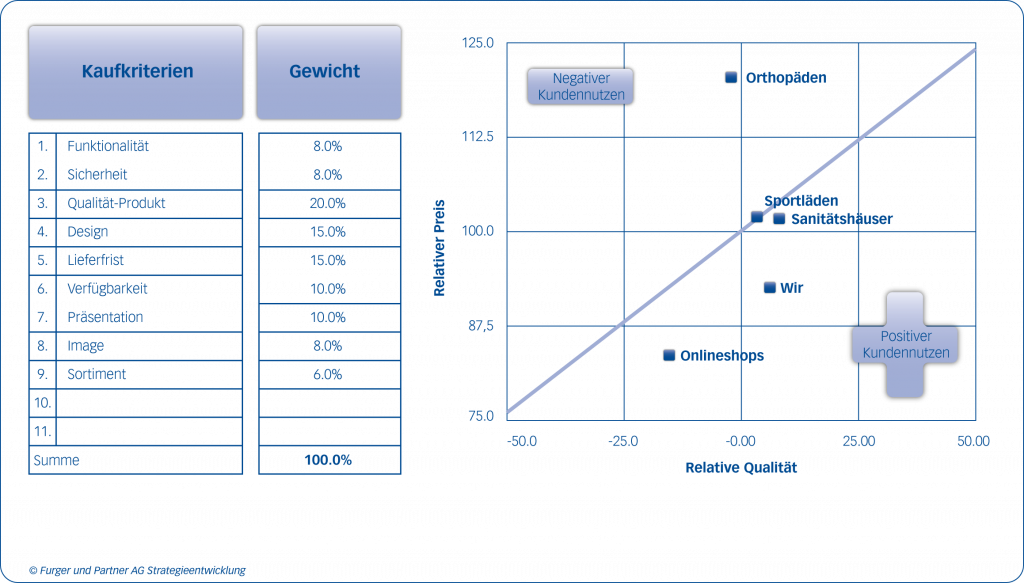
Step 4: Customer Groups and Products
In the next step, the idea will be given further contours by, on the one hand, sharpening the profile of potential customers and, on the other hand, putting the offer together. Osterwalder’s «Value Proposition Design» approach provides valuable assistance in this regard. He assumes that the customer profile can be derived from the «jobs-to-be-done» of the customer as well as the pains and gains in the fulfillment of the tasks. From the considerations to possible «pain relievers», so solution elements for the reduction of the Pains and «Gain-Producers, so solution elements, which are able to donate a customer use, finally the product can be designed. By a product we mean everything that the company «produces» and donates to the customer for money. This includes haptic products, services, services and everything that is today called New German word creations such as «value proposition», «value proposition» and other terms
Complete the remaining fields for the eBMC
On the basis of technologies, customer benefit and offer, the other fields of the eBMC are filled up according to the already classic pattern.
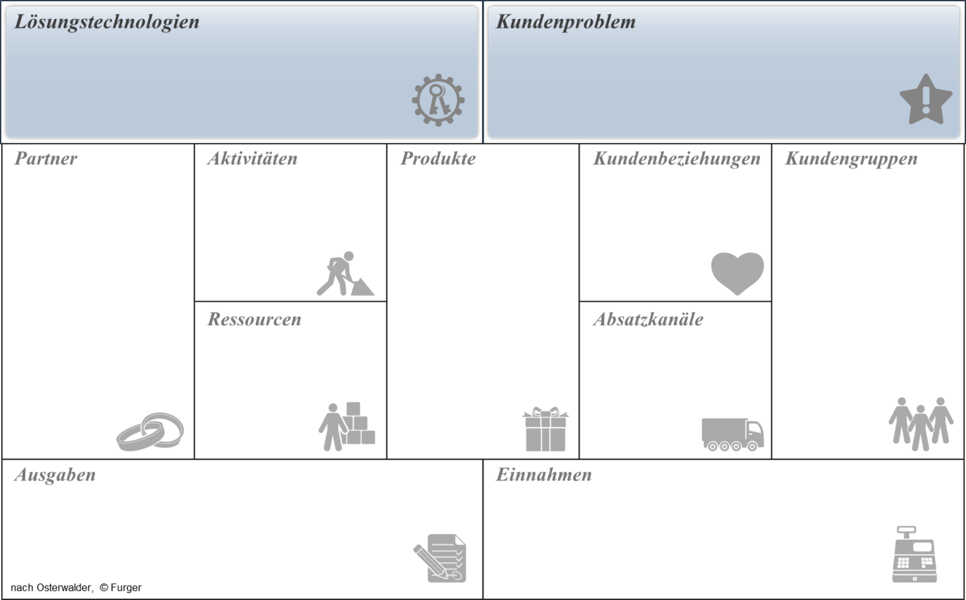
Step 5: Partners, Resources, Activities
No company is alone in the market. List the partners you work with here. This is best done along the value chain; So from the purchase of materials and services on the service to sales; Marketing and communication with the customers, also record the services provided by the partners.
The resources used to create the market offer the following categories: the physical resources (premises, production machines), the intellectual resources (knowledge, patents, partnerships, customer base), the human resources (employees) and the financial resources (available capital, securities).
The key activities describe the processes and competencies needed to ensure service delivery. Again, we cover the entire value chain, which we serve from – to marketing and sales.
Step 6: Customer Groups, Customer Relationship, Sales Channels
Customers can often be divided into groups or segments. In many cases, segmentation also serves for the division into business segments. We recommend equal quantification of these groups, i. with which groups which turnover or even better, which profit is achieved. A good instrument for this is the classic ABC analysis.
The customer relationship also determines the communication with the customer. Between intensive collaboration e.g. There is a whole range of possible relationships with joint developments and pure marketing of the products. Depending on the intensity of the marketing is adjusted accordingly
The sales channels determine how the products or offers come to the customer. Distribution, online channels and points of sale form the interfaces of a company to the target customers.
Step 7: Expenditure
The most important cost factors of a business model are summarized here.
Step 8: Revenue
Here, pricing models and pricing strategies (one-time payment, subscription) are described.
Step 9: Integrate the innovations into the corporate strategy
We can now directly derive the measures from the eBMC for the implementation. If we have highlighted the «new» elements in color, they can easily be formulated.
Alternatively, we can now embed the result in the corporate strategy and develop options, strategic directions with quantitative targets. These then lead to concrete measures and form part of the strategy that will be implemented and accompanied by strategic controlling.
eBMC in the STRATEGY.APP
For each business area, we create the eBMC with the current key elements. Each module is filled accordingly and can be adapted, printed or otherwise communicated at any time:
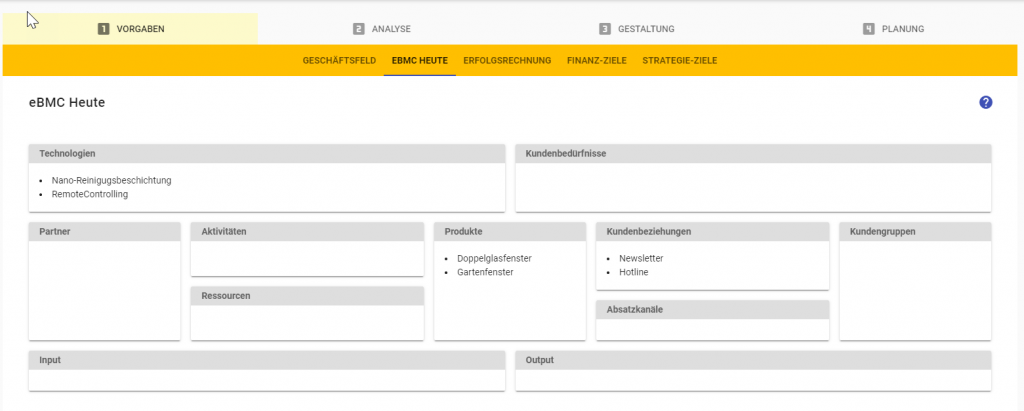
The individual blocks and elements are entered in the usual editing window:
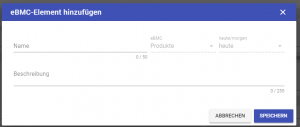
In the design phase, we can now add additional key elements; here e.g. as a new technology, the «nanotechnology» applied to the coating of the glass; or a new sales channel with which customers will be served in the future:
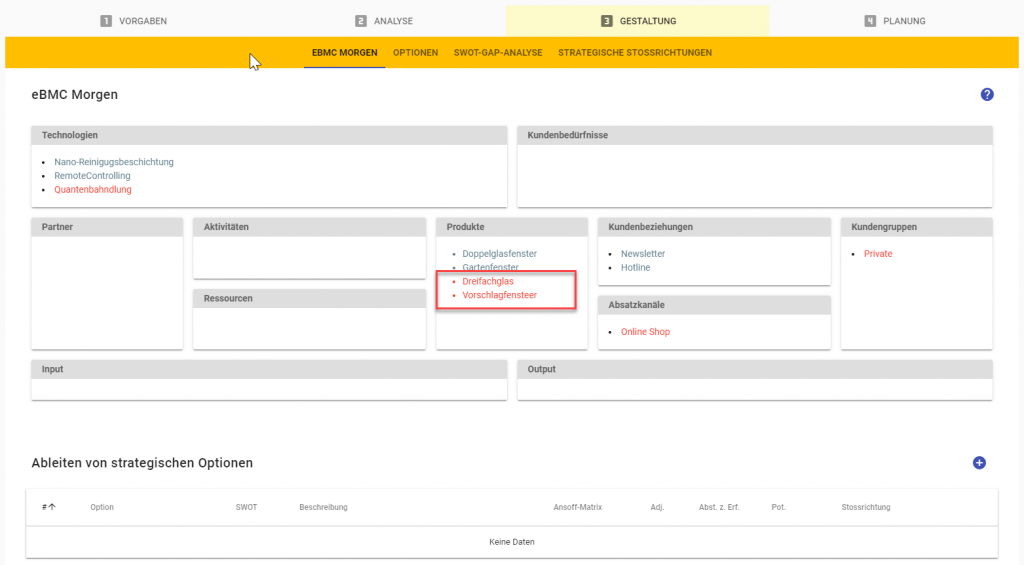
The new elements appear in red for identification. This provides us with a basis for deriving new strategic options and developing strategic directions and measures.
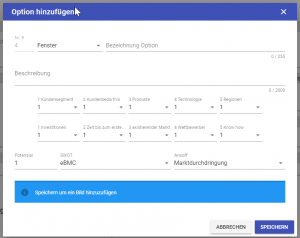
These are then listed in parallel with the options derived from the SWOT.
Here, too, options can be added, added, stopped or deleted at any time.
Literature: « Wunderwaffe Innovation «By Beat Birkenmeier and Harald Brodbeck
Learn more about « Innovation Architecture » at:
beat.birkenmeier@gronova.com +41 41 727 04 70
Schreiben Sie einen Kommentar